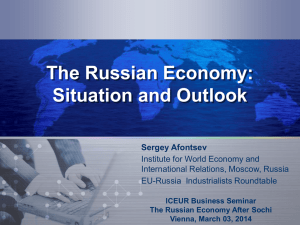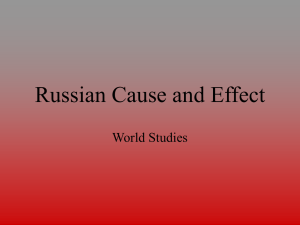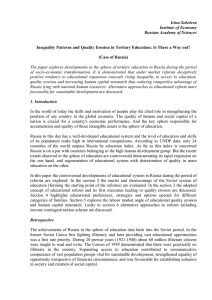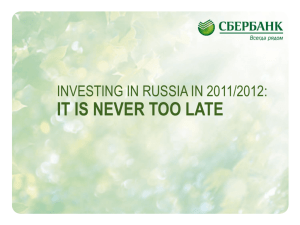Sutela Slides - Carnegie Endowment for International Peace
advertisement
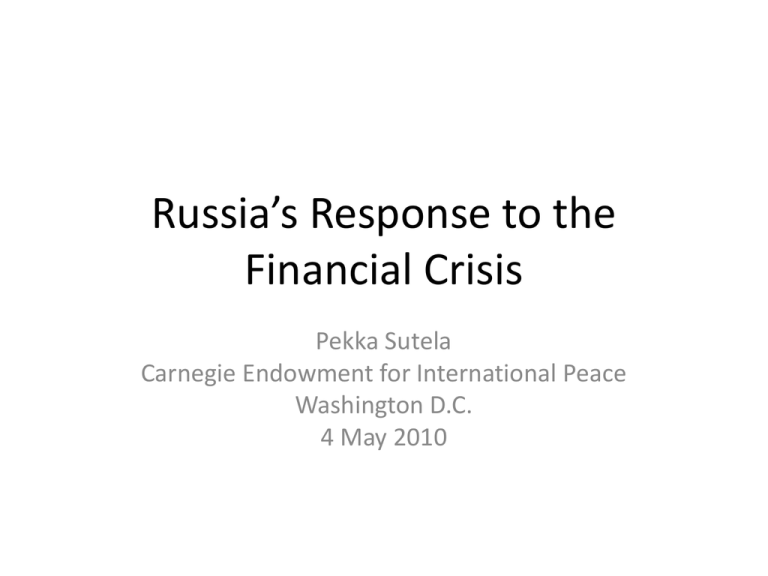
Russia’s Response to the Financial Crisis Pekka Sutela Carnegie Endowment for International Peace Washington D.C. 4 May 2010 A Safe Haven Lost? • • • • • • Russia, like many resource-dependent countries, had learned from earlier crises and accumulated large reserve funds in recent years. In end-2008, they amounted to 225.1 billion USD, in April 2010 to 129.4 billion USD. This was originally at least partly controversial, but the fiscal conservatives lead by Prime Minister Putin and Finance Minister Kudrin now see themselves vindicated. Depending on oil price and other matters, both reserve funds may be exhausted in coming years. Russia will return to reserves accumulation when circumstances allow. Russian leadership distrusted global economic arrangements, and complained privately about a forthcoming crisis they would have to pay for. By early 2008, risks of growth boom based on the combination of high export prices and ample availability of global liquidity were pointed out in Russian economic discussion (e.g. Mau, Vedomosti 14 January 2008) The 2006-2008 preparation of the 2020 program was all about alternatives to perceived excessive resource dependence First policy measures in Fall 2008 did not look improvised Thus, though timing and extent of crisis were unknown, a degree of preparation existed So why the talk of a safe haven? • Politicians are not in the business of doom-saying • Shifting blame to where it belonged: global imbalances • Good grounds why a pure financial crisis might handle Russia softly – Small financial sector; meagre role in investment finance – Little foreign debt, esp. relative to reserves – Strong public sector financial position and quite good creditworthiness with numerous past upgrades – Households with no financial wealth, little debt: no wealth effect on consumption – Labor markets expected to be very flexible Why was the drop so drastic? • Some of the standard explanations deficient – Bad institutions? Yes, but some with worse ones thrived; others with better ones suffered – Resource dependence? Yes, but on the average resource dependent countries fared better than others – Bad policies? With few exceptions Russia’s policies where the standard ones • For a medium income level country, Russia is tradewise exceptionally open; For a resource dependent country, it has a large population • Financial dependence proved important – – – – Debt small, but short-term, concentrated and fast growing Domestic financial deepening partially grew consumption Dependence of financial intermediation on foreign funding drastic The dual financial system: households and most companies using domestic markets; some big companies and banks dependent on foreign markets – Part of a more general pattern: in crisis ownership less important than the source of funding. This is why Eastern and Central Europe fared worse than Latin America Russia’s anti-crisis policies in comparison • Basically similar to those in other countries – And consequently praised by outsiders. Thus, IMF 8 Dec 2009: ”The Russian authorities have continued to manage the fallout of the global financial crisis well” • Comparing size of packets makes little sense – Apples and carrots – Still, fiscal adjustment from 5.4 per cent of GND surplus in 2007 to -5.9 per cent deficit in 2009 is very large – As planned, about half of resources into financial sector support, about half into real economy support • Russia had its peculiarities – The incredible succeeding stepwise devaluation – How, starting with high inflation, to avoid stagflation – Emphasis on monotowns, pensions, minimum wages: crisis fighting as a social policy measure – Structure of the banking system left no alternative to ”favoring” statecontrolled banks as liquidity channels Step-wise devaluation • These usually fail as create expectations on ever more steps • Introduced in December 2008 by Prime Minister’s decision against view of advisors, Central Bank, the IMF and others • Capped in January 2009 with a final about 10 per cent step. Since, nominal exchange rate stable with strong pressure towards appreciation • Devaluation was delayed as reactions of the public, remembering times of dollarization, were feared. This tended to depress production in the expectation of decisions. Still, no market panic or such • In July 2008 – January 2009 currency reserves declined more than expected, about 200 billion USD. But of this, some 50 billion was due to USD/euro exchange rate change, about 100 corresponded to decline in private foreign debt, and the rest basically shifted to private Russian asset holders (”privatization of reserved”) improving their balances Risk of stagflation • After declining almost monotonically since 1998, inflation again increased to double digits in 2007 (11.9 per cent) and 2008 (13.3 per cent), as the economy was overheating • Also, not all financial inflow could be sterilized, incomes increased twice as much as productivity, and controlled prices (including gas central tariffs) were increased • Central bank rates strongly negative in real terms, lending rates on about inflation rate level. Still, nominal rates much above international ones, expected and maintained steady nominal exchange rate • No perceived possibility therefore to cut central bank rates (until 2010). Fiscal policy stance key in anti-crisis measures Anti-crisis measures as social policy • Since 2005 added emphasis on social policy, with view on demography (national priority programs). In practice expenditure on health, education and housing stable as share of budget, increasing in line with total expenditure • Since 2007, decisions to increase pensions, minimum wages, public sector salaries. This continued in spite of crisis, with strong support from Prime Minister. Expenditure on national economy also increased strongly • Economic rationale: very high propensity to consume esp. from pensions. Political rationale: 1/3 of voters on pension. Socio-political rationale: hundreds of company towns (”monotowns”) • Much of increased expenditure permanent, harming future fiscal balance • Another victory of tactics over strategy, as large part of supported industries non-competitive or worse, energy inefficient (against aims of Energy 2030 strategy), or military / dual use (and now longer necessary in view of current security thinking) Social expenditure as a share of consolidated budget expenditure, 2005-2009 (Source: Rosstat, Kaznacheistvo) 2005 2006 2007 2008 2009 Housing 6.9 7.5 9.7 8.2 6.3 Education 11.8 12.4 11.8 11.8 11.2 Health 11.7 11.5 12.1 11.0 10.4 Culture 2.3 2.3 2.2 2.2 2.0 Other 27.7 28.2 25.1 25.8 28.7 - Including pensions 20.8 20.0 17.1 18.4 20.4 State-dominated banking sector • Among largest banks end-2007 only two private Russian ones, three foreign-controlled, five statecontrolled (including big three) • In crisis, private Russians faced funding problems. Some foreign-controlled are for sale. Market share of state-controlled banks (depending on definition) has topped ½ • State-controlled banks used as liquidity channel (esp. Sberbank, Rosselkhozbank) and development bank (VEB) • Little possibility to turn back trend towards more state controls in short-to-medium term Bank of Finland Russia forecast 23 March 2010 • Steeply down; fast up 2007 2008 2009 2010 2011 2012 GDP 8.1 5.6 -7.9 5.5 5 4 Import 27 15 -31 13 10 13 No Easterlin Paradox in Russia: Happiness Follows GDP growth (Guriev and Zhuravskaya 2009) It is the economy: ”What did Putin achieve in ten years?” (Levada Centre 27 July 2009) Political support follows economic welfare 2004:3 2008:3 2009:7 Improved living standard 24 16 22 Economic development 10 21 17 Increased optimism 13 12 9 Order and stability 6 8 8 Stronger int’l position 4 8 7 Challenges for the future • Unpredictable export revenue – Oil price – Energy efficiency needed for maintaining export volumes – Change in gas markets • Regaining budget surplus – Re-accumulating reserve funds a high priority – Expenditure pressure due to recent hikes, long-term needs – Revenue problem due to declining share of energy sector in GDP • Exchange rate policy – Increased flexibility of nominal rate, no pure inflation targeting – Real exchange rate appreciation pressure as financial inflow resumes • Financial system development – Rolling back the state – Need for long-term domestic funding • Pension reform – Increasing dependency ratio – Previous failures to depart from pay-as-you-go • Competitiveness of jobs
